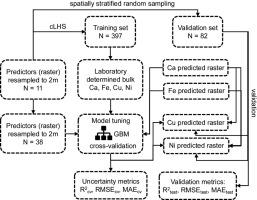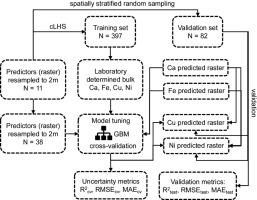土壤类型和宏观元素的含量决定了亚北极工业贫瘠土壤中Cu和Ni积累的热点:来自级联机器学习的推断
IF 7.3
2区 环境科学与生态学
Q1 ENVIRONMENTAL SCIENCES
引用次数: 0
摘要
来自铁和有色金属冶金活动的航空技术污染导致脆弱的自然生态系统退化,是俄罗斯北极地区的主要环境问题。蒙切戈尔斯克(科拉半岛)附近的工业荒地自1950年代以来一直在铜镍冶炼厂的影响区内形成。土壤的异质性、植被的完全或部分退化以及土壤侵蚀加剧的崎岖地形导致冶炼厂排放的铜和镍空中沉积物的横向空间再分布格局复杂。在这项研究中,我们应用级联机器学习(梯度增强机器)来定量描述这些模式。在343公顷的土地上进行了广泛的土壤采样活动(n=506),发现污染水平极高(Cu和Ni的最大体积浓度分别为29.87和30.12 g/kg)。研究结果表明,与不考虑宏观元素与重金属相互作用的模型相比,基于传统预测因子(地形、水文、景观光谱特性)绘制的土壤类型和宏观元素(Ca和Fe)含量图能够更准确地解释空间变异性,尤其是Cu和Ni含量热点。该方法是绘制侵蚀、退化和高污染地区重金属分布图的一种很有前景的工具,对于支持土地复垦计划和分配生物修复措施非常有用。本文章由计算机程序翻译,如有差异,请以英文原文为准。


Soil type and content of macro-elements determine hotspots of Cu and Ni accumulation in soils of subarctic industrial barren: inference from a cascade machine learning
Aerial technogenic pollution from the activity of ferrous and non-ferrous metallurgy resulting in degradation of vulnerable natural ecosystems is a principal environmental problem in Russian Arctic. The industrial barren in the vicinity of Monchegorsk (Kola Peninsula) has been forming since 1950-s in the impact zone of the copper-nickel smelter. Soil heterogeneity, complete or partial degradation of vegetation, and rugged terrain intensified by soil erosion result in complex lateral spatial redistribution patterns of aerial depositions of Cu and Ni emitted by the smelter. In this research, we applied cascade machine learning (gradient boosting machines) to quantitatively describe these patterns. An extensive soil sampling campaign (n=506) across an area of 343 ha has revealed an extremely high levels of contamination (max bulk concentrations of Cu and Ni - 29.87 and 30.12 g/kg). We showed that soil types and the content of macro-elements (Ca and Fe) mapped based on the conventional set of predictors (topography, hydrology, landscape’ spectral properties) explained spatial variability and especially hotspots of Cu and Ni contents with a higher accuracy compared to the models where interactions between macro-elements and heavy metals are not considered. This approach is a promising tool for mapping heavy metals’ distribution in eroded, degraded, and highly polluted areas, which can be very useful to support land reclamation plans and allocate bioremediation measures.
求助全文
通过发布文献求助,成功后即可免费获取论文全文。
去求助
来源期刊

Environmental Pollution
环境科学-环境科学
CiteScore
16.00
自引率
6.70%
发文量
2082
审稿时长
2.9 months
期刊介绍:
Environmental Pollution is an international peer-reviewed journal that publishes high-quality research papers and review articles covering all aspects of environmental pollution and its impacts on ecosystems and human health.
Subject areas include, but are not limited to:
• Sources and occurrences of pollutants that are clearly defined and measured in environmental compartments, food and food-related items, and human bodies;
• Interlinks between contaminant exposure and biological, ecological, and human health effects, including those of climate change;
• Contaminants of emerging concerns (including but not limited to antibiotic resistant microorganisms or genes, microplastics/nanoplastics, electronic wastes, light, and noise) and/or their biological, ecological, or human health effects;
• Laboratory and field studies on the remediation/mitigation of environmental pollution via new techniques and with clear links to biological, ecological, or human health effects;
• Modeling of pollution processes, patterns, or trends that is of clear environmental and/or human health interest;
• New techniques that measure and examine environmental occurrences, transport, behavior, and effects of pollutants within the environment or the laboratory, provided that they can be clearly used to address problems within regional or global environmental compartments.
 求助内容:
求助内容: 应助结果提醒方式:
应助结果提醒方式:


